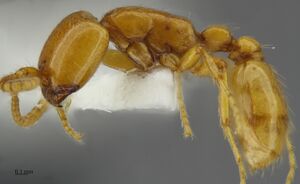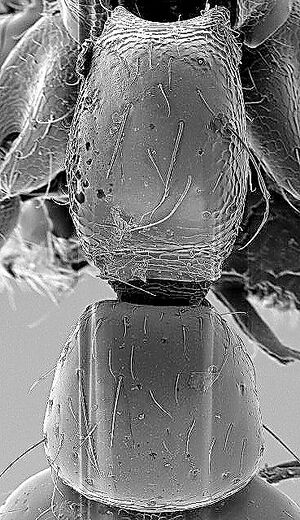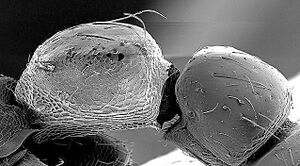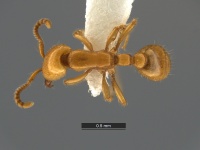Neivamyrmex nyensis
| Neivamyrmex nyensis | |
|---|---|

| |
| Scientific classification | |
| Kingdom: | Animalia |
| Phylum: | Arthropoda |
| Class: | Insecta |
| Order: | Hymenoptera |
| Family: | Formicidae |
| Subfamily: | Dorylinae |
| Genus: | Neivamyrmex |
| Species: | N. nyensis |
| Binomial name | |
| Neivamyrmex nyensis Watkins, 1977 | |
This small subterranean species is poorly known. Not surprisingly most of these collections were from under partially buried stones; a Glamis sample consists of a single specimen taken from a foraging worker of Forelius mccooki (Forel) and a Lucerne Valley record is based on a head capsule recovered from a refuse midden of Solenopsis xyloni McCook. A Red Cloud Canyon site is in a rocky streambed on the west side of the range, in Creosote/Cactus Scrub desert. The specimens were collected in late afternoon beneath a partially buried stone. There had been rain several days prior to the collection and the soil under the stone was slightly damp. A Havasu Canyon collection was made under similar circumstances. Neivamyrmex nyensis may eventually prove to be the worker form of Neivamyrmex mojave. (Snelling and Snelling 2007)
Identification
These ants are rather small (1.7 to 2.5 mm in length) and light yellow in color.
Watkins (1977)- Workers: postpetiole distinct; antennal fossae not concealed by frontal carinae; tarsal claws without teeth; dorsum of mesonotum straight; antennal scape not exceeding eye level; transverse carina absent at juncture of dorsal and descending surfaces of propodeum; descending surface of propodeum not distinctly indented or concave; dorsum of propodeum longer than descending surface (lateral view); eye without a distinct convex cornea; upper (basal) edge of mandible straight to a tooth-like comer, then concave to the upper tooth of the masticatory edge; eyes reduced to faint yellow specks below cuticle; concave portion of posterior head margin as wide or wider than greatest width of alitrunk; petiole distinctly elongate (dorsal view); dorsum of mesonotum and propodeum forming a straight line with an indistinct juncture; postpetiole distinctly broader than petiole; although the anteroventral comer of the petiole forms a protuberance, the anteroventral tooth is completely absent; entire body yellowish; length 1.7-2.5 mm.
Keys including this Species
Distribution
United States: Southern Nevada, Arizona, California; Mexico: Baja California.
Latitudinal Distribution Pattern
Latitudinal Range: 38.042382° to 31.51667°.
| North Temperate |
North Subtropical |
Tropical | South Subtropical |
South Temperate |
- Source: AntMaps
Distribution based on Regional Taxon Lists
Nearctic Region: United States (type locality).
Neotropical Region: Mexico.
Distribution based on AntMaps
Distribution based on AntWeb specimens
Check data from AntWeb
Countries Occupied
| Number of countries occupied by this species based on AntWiki Regional Taxon Lists. In general, fewer countries occupied indicates a narrower range, while more countries indicates a more widespread species. |

|
Estimated Abundance
| Relative abundance based on number of AntMaps records per species (this species within the purple bar). Fewer records (to the left) indicates a less abundant/encountered species while more records (to the right) indicates more abundant/encountered species. |

|
Biology
This ant species is rather uncommon, it was found at the base of the Coconino Rim along Old Route 64 about 32 kilometers West of Cameron on the Navajo Reservation. A colony was found under a rock at about 7PM. Workers are polymorphic. Colonies were also found on the Navajo Reservation at two separate localities near Dilkon in juniper/pinon habitat.
Castes
Worker
   
| |
| . | Owned by Museum of Comparative Zoology. |
  
| |
| Photographer Gordon Snelling. | |
Images from AntWeb
   
| |
| Worker. Specimen code casent0005333. Photographer April Nobile, uploaded by California Academy of Sciences. | Owned by UCDC, Davis, CA, USA. |
Queens and males are unknown.
Nomenclature
The following information is derived from Barry Bolton's Online Catalogue of the Ants of the World.
- nyensis. Neivamyrmex nyensis Watkins, 1977b: 421, figs. 1-4 (w.) U.S.A. (Nevada).
- Type-material: holotype worker, ca 100 paratype workers.
- Type-locality: holotype U.S.A.: Nevada, Nye County, 5.5 mi. S, 3 mi. E Beatty, 3500 ft, 15.v.1970 (G.C. & J. Wheeler); paratypes with same data.
- Type-depositories: LACM (holotype); DRIR, JFWC, LACM, USNM (paratypes).
- Status as species: Watkins, 1985: 482 (in key); Wheeler, G.C. & Wheeler, J. 1986g: 20; Bolton, 1995b: 290; Ward, 2005: 62; Snelling, G.C. & Snelling, 2007: 486.
- Distribution: Mexico, U.S.A.
Unless otherwise noted the text for the remainder of this section is reported from the publication that includes the original description.
Description
Worker
(Holotype). Length 2.2 mm. Head (Fig. 2): median length 0.62 mm; greatest width 0.5 mm; slightly narrowed posteriorly (upper surface from frontal view) with rounded corners and a slightly concave upper border; frontal carinae short, but distinct, and curving below the antennal fossae to form broad Ranges. Eyes indistinct and reduced to tiny yellowish specks below the cuticle. Antenna: scape: length 0.37 mm; apical width 0.1 mm; bent basally and widened distally. Flagellum: length 0.87 mm; incrassated; width segment one 0.05 mm, five 0.06 mm, ten 0.08 mm; length of segments one through seven 0.05-0.06 mm, eight 0.07 mm, nine and ten 0.1 mm, eleven 0.18 mm. Mandible (anteroventral view, Fig. 4): length 0.31 mm; somewhat triangular; straight upper edge ending in a tooth-like corner; edge between tooth-like corner and upper tooth of masticatory margin concave; masticatory surface irregular with three distinct teeth (upper, submedial, apical).
Alitrunk (Fig. 1, lateral view): length 0.82 mm; dorsum straight except for the gradually down-curved anterior surface of the pronotum; juncture of mesonotal and propodeal surfaces barely indicated by a slight indentation; weak transverse carina at anterior border of pronotum; dorsum of propodeum longer than descending surface and the two surfaces forming an angle of about 1350 with a slightly rounded juncture.
Petiole: elongate with slightly convex sides; anterior border slightly concave with distinct corners; node length 0.25 mm, greatest width 0.17 mm (dorsal view, Fig. 3); dorsum of node evenly convex; ventral surface with a weak anterior proturbance, but without a distinct anteroventral tooth; height 0.2 mm (lateral view, Fig. 1).
Postpetiole: subquadrate, slightly trapezoidal with rounded corners; length 0.2 mm; greatest width 0.22 mm (dorsal view, Fig. 3); height 0.22 mm; dorsum of node weakly convex; anteroventral corner angular (lateral view, Fig. 1).
Gaster (Fig. 1): length 0.8 mm, greatest width 0.52 mm, greatest height 0.4 mm; oval from a dorsal view, and somewhat compressed, elongate oval from a lateral view; stinger small.
Legs: proleg: coxa conical, length 0.22 mm; trochanter length 0.09 mm, width 0.07 mm; femur length 0.47 mm, enlarged in middle, median width 0.15 mm; tibia length 0.37 mm, width 0.1 mm, apical strigile well developed; tarsus length 0.4 mm, proximal segment slightly bent and almost as long as remaining segments combined, claws Simple. Metaleg: coxa length 0.17 mm, width 0.12 mm, less conical than pro coxa; trochanter length 0.07 mm, width 0.05 mm, femur length 0.5 mm, enlarged in middle, median width 0.12 mm; tibia length 0.5 mm, enlarged distally, greatest width 0.08 mm, apical strigile well developed; tarsus length, segment one 0.35 mm, two 0.15 mm, three 0.12 mm, four 0.07 mm, five 0.12 mm, claws simple.
Entire body smooth and shining, except some granulation on mesopleuron, sides of propodeum and dorsal mesonotal-propodeal juncture, and scattered indistinct punctation on head and dorsum of alitrunk (50X). Scattered semierect setae on most surfaces. Entire body yellowish brown except for darker reddish-brown mandibles.
Variations. Workers (about 100 examined): length 1.7-2.5 mm. The middle tooth on the masticatory edge of the mandible varies from distinct to absent on a few specimens. The dorsal mesonotal-propodeal juncture varies from weakly indented to a few darkened irregularities to completely invisible. Transverse carina on dorsum of anterior border of pronotum absent on smallest workers. The smallest workers lack almost all of the granulations and weak punctation present on some areas of the larger workers.
Type Material
U.S.A., Nevada, Nye Co., 5 1/2 miles south and 3 miles east of Beatty, 3500 feet.
Workers. Red determination labels. Collected by C. C. and J. Wheeler; 15 May 1970: U.S.A., Nevada, Nye Co., S. E. of Beatty, 3500 feet. The holotype is deposited in the Los Angeles County Museum of Natural History, Los Angeles, Calif., U.S.A. Paratypes are deposited in the Los Angeles County Museum of Natural History; National Museum of Natural History, Wash., D. C., U.S.A.; C. C. Wheeler Collection, Desert Research Inst., Reno, Nevada, U.S.A.; and Watkins Collection, Baylor Univ., Waco, Texas, U.S.A.
Nye Co.; Sand 3 mi. E Beatty; coll. G.C. and J. Wheeler #797; 16 April 1970 (not 15 May 1970); 3,500 ft.; on western slope of Bare Mt. in very rocky terrain. The bivouac was under two contiguous slightly buried stones each about 15 x 20 x 30 cm.
References
- Alatorre-Bracamontes, C.E., Vásquez-Bolaños, M. 2010. Lista comentada de las hormigas (Hymenoptera: Formicidae) del norte de México. Dugesiana 17(1): 9-36.
- Snelling, G. C.; Snelling, R. R. 2007. New synonymy, new species, new keys to Neivamyrmex army ants of the United States. In Snelling, R. R., B. L. Fisher, and P. S. Ward (eds). Advances in ant systematics (Hymenoptera: Formicidae): homage to E. O. Wilson - 50 years of contributions. Memoirs of the American Entomological Institute 80:459-550. PDF
- Watkins, J. F., II. 1977b. Neivamyrmex nyensis, n. sp. (Formicidae: Dorylinae) from Nye County, Nevada, U.S.A. Southwestern Naturalist. 22:421-425. (page 421, figs. 1-4 worker described)
References based on Global Ant Biodiversity Informatics
- Dattilo W. et al. 2019. MEXICO ANTS: incidence and abundance along the Nearctic-Neotropical interface. Ecology https://doi.org/10.1002/ecy.2944
- Johnson, R.A. and P.S. Ward. 2002. Biogeography and endemism of ants (Hymenoptera: Formicidae) in Baja California, Mexico: a first overview. Journal of Biogeography 29:10091026/
- Snelling G. C. and R. R. Snelling. 2007. New synonymy, new species, new keys to Neivamyrmex army ants of the United States. Memoirs of the American Entomological Institute 80: 459-550
- Vásquez-Bolaños M. 2011. Lista de especies de hormigas (Hymenoptera: Formicidae) para México. Dugesiana 18: 95-133
- Watkins J. F., II 1977. Neivamyrmex nyensis, n. sp. (Formicidae: Dorylinae) from Nye County, Nevada, U.S.A. The Southwestern Naturalist 22: 421-425.
- Wheeler G. C., and J. Wheeler. 1986. The ants of Nevada. Los Angeles: Natural History Museum of Los Angeles County, vii + 138 pp.


